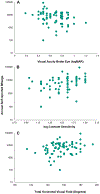Vision, Driving Exposure, and Collisions in Bioptic Drivers
- PMID: 34889860
- PMCID: PMC8816860
- DOI: 10.1097/OPX.0000000000001836
Vision, Driving Exposure, and Collisions in Bioptic Drivers
Abstract
Significance: Lack of knowledge regarding the mileage driven by drivers with low vision who use bioptic telescopes could obscure the relationship between vision and road safety. This study provides data suggesting that worse vision is correlated with less mileage driven but more collisions per mile in bioptic drivers.
Purpose: The purpose of this study was to determine whether vision or demographic factors predict mileage driven in bioptic drivers and per-mile motor vehicle collision rate and also to compare the collision rate of bioptic drivers with previous estimates for the general population.
Methods: Driver data were collected retrospectively from clinic records. Collision data were collected from the Ohio Bureau of Motor Vehicles database. Subjects were also asked to estimate their yearly mileage. Regression models were used to investigate relationships between vision and collision rates.
Results: Seventy-three licensed Ohio bioptic drivers (36 male) were included. Mean ± standard deviation age was 51 ± 16 years. Mean logMAR visual acuity was 0.67 (approximately 20/100). Mean log contrast sensitivity was 1.57. Mean reported annual mileage was 9746. Age, sex, and previous (nonbioptic) driving experience were not associated with mileage. LogMAR visual acuity was inversely related to mileage (P = .02), and contrast sensitivity (P = .01) and horizontal visual field (P = .02) were directly associated with mileage. Visual acuity (P = .02) and visual field (P = .005), but not contrast sensitivity (P = .19), were associated with number of collisions.
Conclusions: Visual acuity, visual field, and contrast sensitivity were associated with driving exposure in bioptic drivers (with drivers with poorer vision reporting lower annual mileage), and poorer visual acuity and visual field were associated with more collisions. The per-mile collision rate for bioptic drivers was within the range of that previously reported for fully sighted drivers, although higher than would be expected for fully sighted drivers of similar age distribution.
Copyright © 2021 American Academy of Optometry.
Conflict of interest statement
Conflict of Interest Disclosure: None of the authors have reported a financial conflict of interest.
Figures
References
-
- American Medical Association (AMA). Physician’s Guide to Assessing and Counseling Older Drivers. Chicago: AMA; 2010.
-
- Marottoli RA, de Leon CFM, Glass TA, et al. Consequences of Driving Cessation: Decreased Out-of-home Activity Levels. J Gerontol (B) 2000;55:S334–40. - PubMed
-
- Marottoli RA, Mendes de Leon CF, Glass TA, et al. Driving Cessation and Increased Depressive Symptoms: Prospective Evidence from the New Haven EPESE. Established Populations for Epidemiologic Studies of the Elderly. J Am Geriatr Soc 1997;45:202–6. - PubMed
-
- Fonda SJ, Wallace RB, Herzog AR. Changes in Driving Patterns and Worsening Depressive Symptoms among Older Adults. J Gerontol (B) 2001;56:S343–51. - PubMed
Publication types
MeSH terms
Grants and funding
LinkOut - more resources
Full Text Sources



